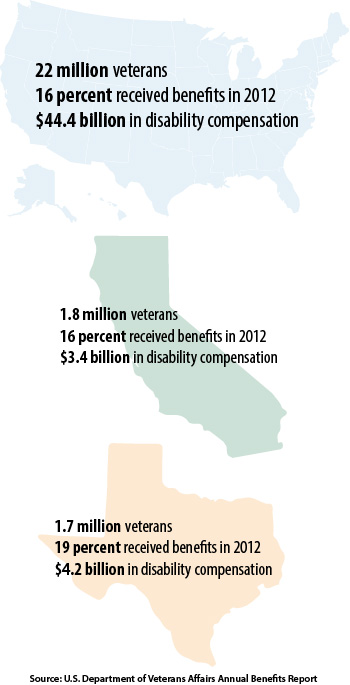Texas, California Help Reduce VA Claims Backlog
By Eva Lorraine Molina
For Reporting Texas
The federal Veterans Benefits Administration is beginning to reduce its huge claims backlog with assists from lawmakers in Texas and California, but new challenges are arising and much work remains.
More than 640,000 claims still await processing, according to the VBA’s workload report for the week that began Dec. 9 — down about a third from the backlog peak in spring 2012. After a state-run program helped process additional claims in Texas, California created a similar program, and other states are taking notice. But now more appeals are being filed than usual, perhaps because of errors in the rush to process claims.
For U.S. military veterans to receive benefits for service-related disabilities, they must submit claims to the Veterans Benefits Administration, a division of the Department of Veterans Affairs. The VBA must then rate the claims, a process that now takes about a year. Rating means the agency determines how much of a disability is related to ailments a veteran had during his or her service. The rating can mean the veteran receives free care at a VA hospital or a monthly check to cover medical or other costs.
Paul Sullivan, a veteran of the first Gulf War and spokesman at Bergmann & Moore, a law firm that specializes in disability claims, said the VBA has had “a chronic problem” in rating claims quickly and accurately. But it wasn’t until 2010 that it “hit catastrophic levels,” he said. Sullivan is also a former VBA employee who used to monitor the backlog.
At least three factors may have worsened the problem. First, in the spring of 2010, President Barack Obama expanded benefits to Vietnam War veterans exposed to Agent Orange, which resulted in hundreds of thousands of new disability claims. That summer, Obama also expanded benefits for war veterans with post-traumatic stress disorder. Third, wars in Iraq and Afghanistan have steadily increased the number of veterans over the past decade.
Sullivan said he’s glad states are pitching in. “The VA needs all the help it can get,” he said.
The Texas model
The disability claims crisis was especially bad in Texas, where about 1.7 million veterans live. Disability claims doubled and the backlog quadrupled from 2010 to 2012. In the summer of 2012, the VA regional office in Waco was the slowest in the country. The state’s efforts to assist the VA have attracted nationwide attention.

Texas and California, the nation’s two most populous states,
together account for nearly a sixth of the nation’s veterans.
Infographic by Logan Molyneux.
In July 2012, state leaders allocated $1.5 million to the Texas Veterans Commission, the state’s veterans agency, to fund a one-year push to reduce the backlog.
One problem was that many claims were incomplete, which delayed decisions. So the TVC created teams of expert counselors to help veterans provide the VBA with completed claims. So-called strike force teams each have eight counselors and review backlogged claims to gather additional evidence. The fully developed claim teams each have five counselors who work to ensure that new claims are submitted with all necessary documentation.
Since September 2012, the teams have provided the VBA with more than 40,000 completed claims ready for rating.
Two teams are located at each of the VA regional offices in Waco and Houston. Another eight counselors are dispersed throughout the state.
“The results have been incredible,” said Jim Richman, TVC’s director of claims representation and counseling.
Since September 2012, the backlog in the Waco office has been cut in half, from 50,268 to 25,512. Backlogged claims in Houston fell from 37,892 to 28,281.
Because of their success, the TVC’s teams now have the full backing of state leaders.
“The governor, lieutenant governor, speaker and now the Legislature have voted to continue to support our efforts,” Richman said.
In January, state leaders approved an additional $500,000 for the teams. The Legislature has appropriated $4 million to fund the initiative through 2015.
The additional money allowed Richman to hire 50 more counselors to help assure that new claims are complete, placing the counselors in “critical need areas” throughout the state.
Richman estimates about $2.6 billion in disability compensation has been paid out to veterans the TVC represents.
Richman said he’s received calls from other states about the Texas initiative and is happy to help.
Piggybacking in California
Texas’s initiative inspired California, the state with the most veterans. In July, Gov. Jerry Brown set aside $3 million for the California Department of Veterans Affairs, known as CalVet, to develop teams modeled after the Texas teams.
“We kind of piggybacked off of Texas,” said Keith Boylan, CalVet deputy secretary, who sought Richman’s guidance in designing his program.
The California teams will consist of 36 counselors, 12 in each of the VA regional offices in San Diego, Oakland and Los Angeles. Eight counselors will review backlogged claims, and the other four will work to fully develop new claims.
The federal government shutdown in October delayed CalVet’s hiring process, but with only 25 counselors hired, the teams have already returned 861 completed claims to the VBA.
Boylan plans to hire the remaining 11 counselors and have the teams fully functioning by January. He hopes the teams can process 2,000 claims per month.
“Although this is a federal problem, we needed to get involved for the sake of our vets,” Boylan said.
As the states join the fight to reduce the federal backlog, the number of new claims is declining nationally.
“What’s happening now is a second crisis,” Sullivan said. “As the number of new claims is going down — that’s good — the number of appeals is going way up, and that’s bad.”
In their haste to reduce the backlog, VBA employees sometimes made mistakes processing claims.
“Now we’re seeing a skyrocketing of appealed claims,” Sullivan said. “The number has reached about 250,000.”
The average wait time for a decision from the Board of Veteran Appeals is 3.5 years.